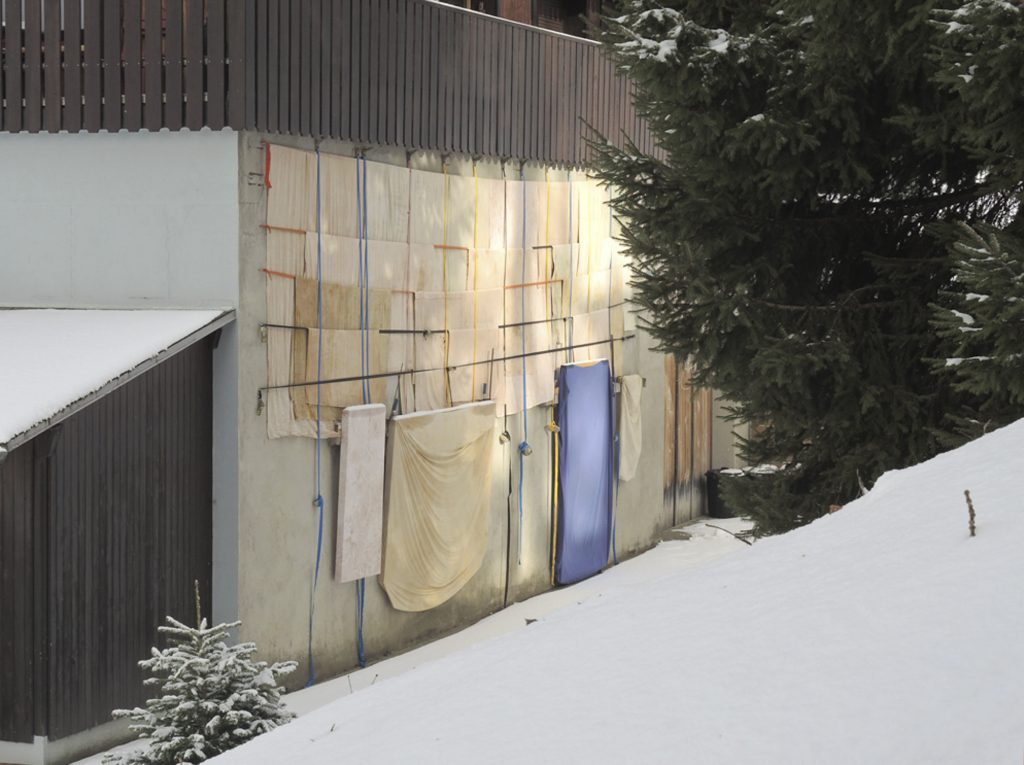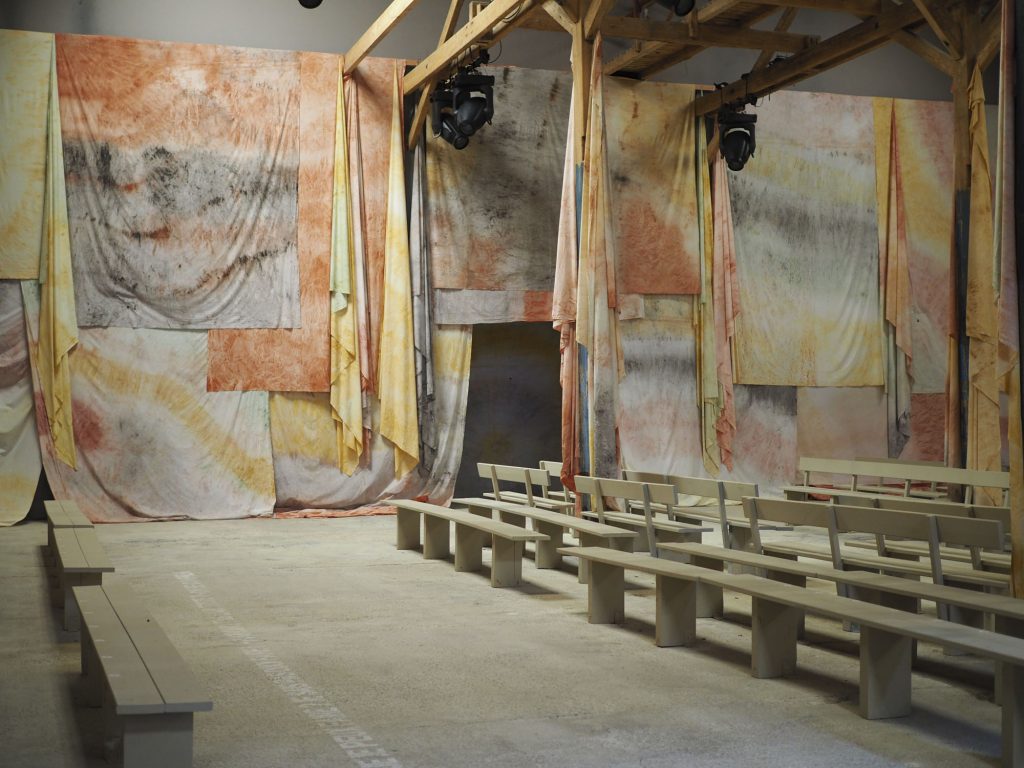Adrien Vescovi: The Art of Letting Go
TLmag speaks to French visual artist Adrien Vesovi who, after a serious skiing accident in 2004, adopted a repetitive artistic process that still leaves room for surprise – creating what he likes to call “wanted accidents”.
French artist Adrien Vescovi makes rustic textile paintings by repeatedly exposing natural fabrics to outdoor conditions. Through experimentation, semi-controlled instances of chance and years of experience, Vescovi has developed a practice that creates “wanted accidents,” like fading due to prolonged exposure to the sun, or rips due to strong winds. By knowing when to let go and leave things to take their natural course, Vescovi’s work reflects on the passage of time and observes a climate in a state of transformation and change in both a poetic and literal sense, all the while highlighting sustainability and bringing questions of authorship into play. Here, TLmag spoke to Adrien about the repetitive nature of his artistic process, how his environment influences his choices of materials as well as his new patchwork pieces that will be shown in various cities in France later this year.
TLmag: In 2004, you were in a serious skiing accident that left you in a coma for some time and left you with permanent issues of memory loss. How has your artistic practice been affected by this event?
Adrien Vescovi (AV): To remind myself of the steps in my process, I decided to repeat the movements over and over again until I could remember them. As my work questions time, I quickly implemented processes that create a record of themselves by using a combination of movements that I undertake myself as well as others that are a result of “Laissez-faire” [letting go]. New axes of research also appear through the dialogue between the interior and the exterior of the studio, and via the accidents that I familiarise myself with by trying to repeat them. With each try, I attempt to control this method of chance. It is through repetition that things transform and move, and ultimately the intention of these experiments is always to surprise myself.
TLmag: The colours and materials that you use in your work often coincide with the season and location in which you made them. Would you talk us through the process of your material research?
AV: My research with textiles has encompassed many different experiments, and mostly depends on my surroundings: the place that I find myself in, the season, and the materials that I can find around my workspace. To prepare for an exhibition, back in February 2015, I set up my studio in my grandfather’s old workshop near where I grew up (Haute Savoie), high up in the mountains. For three months, I mostly worked with the ultra-violet rays from the moon and sun. At 1600m above sea level, the UV rays are way more powerful, and so the discolouration and transformation of my textiles happened more quickly. There, I found both a type of light and solitude that enabled me to concentrate on my painting. In October of the same year, I rediscovered the forgotten colours of the autumn forest: the trees were afire with brilliant reds, bright yellows, and intense oranges. I realised that my next colours were right there, and all I had to do was use them — so I began by creating a “landscape juice” from plant decoctions. Now that I live in Marseilles, my plant colours have become more mineral and are made using ochre’s that I collect in Roussillon or Vaucluse, as well as Morocco and Italy. My palette has also moved to the south.
TLmag: You’ve described your work as a “wanted accident” — leaving a lot up to chance and using natural elements that are outside of your control. How do you work with that delicate balance between the opportunities and experimentation versus maintaining your artistic control?
AV: Indeed, chance does play an essential role in my painting — but I consider it to be ‘controlled’ chance because I repeat my attempts several times. I leave long pieces of textile outside for periods of more than three months, and, sometimes, I even rework the textiles for a second or third time; the process never ends. I regularly show my textiles in one form a first time, then recuperate them and transform them again. For example, as part of an installation that covered a former school in a public park for theIntoNature biennialin Fredericksoord last year, I presented a 150-metre installation of textiles that I dyed and exposed to the elements for more than five years in Marseille. The same textiles were returned to the studio and treated, cleaned and assembled in order to be exhibited in Nice at the Galerie des Ponchettes within a new installation during the ‘Mnémosyne’exhibition. I think of my relationships with my paintings as being like those you can have with people: you meet someone for the first time, time passes, and they change. Then, when you meet them for the second time, they’re different — and it will be even more so the next time you meet them.
TLmag: Does your studio practice, and the creation of your works, inform the way you present them in a white cube/exhibition setting?
AV: My studio practice is incredibly important, as I spend more than 10 hours there every day. I do a lot of manipulations, try different ways to hang things, leave them hanging, I look at them — and repeat. I continuously find new ways to show my work within my studio. I like when the edges between an ongoing work and the way to exhibit it “meet up”, and like to extract forms from the studio into the exhibition space presentation. It’s even more interesting to do this outside, exposed to the light and the elements when the textiles are in the process of transforming.
TLmag: Even though you primarily work with textiles and plant dyes, you mostly refer to your work and practice as painting. How do you continue to experiment in your work, especially seeing this link to painting which seems so traditional?
AV:My work is tied to time in a very romantic way: it’s a memory of our era, a mute recording of a climate transforming and changing. It’s an observation, a trace, a memory of this time that is passing. My intention with painting is to find different forms for exposing my work. There’s the traditional painting, stretched on a frame (which I refer to as a window to time); the free-standing canvas, which is hung in a space that creates circulation movements; and the monumental installation, which is covering a building, masking it and/or hiding it. For me, all of these explorations come together under the aegis of the ‘painting’, in a research into the transformation of the painting, through the exploration of colour.
TLmag: You recently paid tribute to Franz Elemental Design by creating a series of benches with one of your paintings. I can imagine that’s quite a different way of working for you. How did this collaboration come about?
AV: These benches have a rather unique status because this was first and foremost a request from the Impermanent Collection. When I was contacted by Eugénie Frémiot and Emilie Pischedda for this project, I had just presented a series of hammocks at the Kunsthalle Charlottenborg (Copenhagen) in which the spectator was inside the painting, wrapped in the canvas. After several meetings and discussions, we wanted to extend this research — and confront it with more rigid furniture to pose the question of how the spectator would sit on the painting. The response was “that’s not a problem”, and I’m incredibly happy that our collaboration developed in this way.
TLmag: Could you tell us about some of the new works that you’ll be showing this year?
AV: I am currently working on new pieces that start from forms which are designed and assembled by machine, like patchwork. These free-standing canvasses will take different forms during their exhibitions. At the Palais de Tokyo in Paris for example, the spectator will be invited to penetrate a corridor of canvasses to traverse the painting, whereas, at the Veille Charité in Marseilles, there will be a 19th-century chapel covered by two monumental paintings. Finally, before the end of 2019, I’m working on a painting which will be exhibited on the ground, in which the observer has to move through it whilst wearing socks as part of a collective exhibit at the Musée Régional d’Art Contemporain in Serignan.
Adrien is currently based in the city artist studios of Marseille.
https://adrienvescovi.tumblr.com, @ardeinv

















